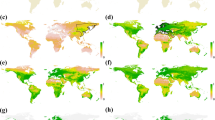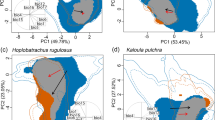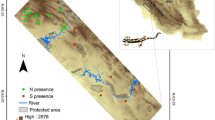Abstract
The use of species distribution models (SDMs) to predict potential distributions of species is steadily increasing. A necessary assumption when projecting models throughout space or time is that climatic niches are conservative, but recent findings of niche shifts during biological invasion of particular plant and animal species have indicated that this assumption is not categorically valid. One reason for observed shifts may relate to variable selection for modelling. In this study, we assess differences in climatic niches in the native and invasive ranges of the Greenhouse frog (Eleutherodactylus planirostris). We analyze which variables are more ‘conserved’ in comparison to more ‘relaxed’ variables (i.e. subject to niche shift) and how they influence transferability of SDMs developed with Maxent on the basis of ten bioclimatic layers best describing the climatic requirements of the target species. We focus on degrees of niche similarity and conservatism using Schoener's index and Hellinger distance. Significance of results are tested with null models. Results indicate that the degrees of niche similarity and conservatism vary greatly among the predictive variables. Some shifts can be attributed to active habitat selection, whereas others apparently reflect variation in the availability of climate conditions or biotic interactions between the frogs' native and invasive ranges. Patterns suggesting active habitat selection also vary among variables. Our findings evoke considerable implications on the transferability of SDMs over space and time, which is strongly affected by the choice and number of predictors. The incorporation of ‘relaxed’ predictors not or only indirectly correlated with biologically meaningful predictors may lead to erroneous predictions when projecting SDMs. We recommend thorough assessments of invasive species' ecology for the identification biologically meaningful predictors facilitating transferability.




Similar content being viewed by others
References
Aaújo MB, Rahbek C (2006) How does climate change affect biodiversity? Science 313:1396–1397
Anderson RP, Raza A (2010) The effect of the extent of the study region on GIS models of species geographic distributions and estimates of niche evolution: preliminary tests with montane rodents (genus Nephelomys) in Venezuela. J Biogeogr 37:1378–1393
Araújo MB, Pearson RG (2005) Equilibrium of species' distribution with climate. Ecography 28:693–695
Araújo MB, Cabeza M, Thullier W, Hannah L, Williams PH (2004) Would climate change drive species out of reserves? An assessment of existing reserve-selection methods. Glob Chang Biol 10:1618–1626
Araújo MB, Thuiller W, Pearson RG (2006) Climate warming and the decline of amphibians and reptiles in Europe. J Biogeogr 33:1712–1728
Beard KH, Pitt WC (2005) Potential consequences of the coqui frog invasion in Hawaii. Divers Distrib 11:427–433
Beaumont LJ, Hughes L, Poulsen M (2005) Predicting species distributions: use of climatic parameters in BIOCLIM and its impact on predictions of species' current and future distributions. Ecol Model 186:250–269
Beaumont LJ, Gallagher RV, Thuiller W, Downey PO, Leishman MR, Hughes L (2009) Different climatic envelopes among invasive populations may lead to underestimations of current and future biological invasions. Divers Distrib 15:409–420
Bomford M, Kraus F, Barry SC, Lawrence E (2009) Predicting establishment success for alien reptiles and amphibians: a role for climate matiching. Biol Invasions 11:1387–3547
Brand M, Grossenbacher K (1979) Untersuchungen zur Entwicklungsgeschwindigkeit der Larven von Triturus a. alpestris (Laurent 1768), Bufo b. bufo (Linnaeus 1758) und Rana t. temporaria (Linnaeus 1758) aus Populationen verschiedener Höhenstufen in den Schweizer Alpen. Selbstverlag, Bern
Broennimann O, Guisan A (2008) Predicting current and future biological invasions: both native and invaded ranges matter. Biol Let 4:585–589
Broennimann O, Treier UA, Müller-Schärer H, Thuiller W, Peterson AT, Guisan A (2007) Evidence of climatic nich shift during biological invasion. Ecol Lett 10:701–709
Brown JL, Twomey E (2009) Complicated histrories: three new species of poison frogs of the genus Ameerega (Anura: Dendrobatidae) from north-central Peru. Zootaxa 2049:1–38
Busby JR (1991) BIOCLIM—a bioclimatic analysis and prediction system. In: Margules CR, Austin MP (eds) Nature, conservation: cost effective biological surveys and data analysis. CSIRO, Melbourne, pp 64–68
Carpenter G, Gillison A, Winter J (1993) DOMAIN: a flexible modelling procedure for mapping potential distributions of plants and animals. Biodivers Conserv 2:667–680
Dundee HA, Rossman DA (1989) Amphibians and reptiles of Louisiana. Louisiana State University Press, Baton Rouge
Ehrlich PR (1989) Attributes of the invaders and the invading process: vertebrates. In: Drake JA, Mooney HA, di Castri F, Groves RH, Wiliamson M (eds) Biological invasions: a global perspective. Wiley, New York, pp 315–328
Elith J, Graham CH, Anderson RP, Dudik M, Ferrier S, Guisan A, Hijmans RJ, Huettmann F, Leathwick JR, Lehmann A, Li J, Lohmann LG, Loiselle BA, Manion G, Moritz C, Nakamura M, Nakazawa Y, Overton JMM, Perterson AT, Phillips SJ, Richardson K, Scachetti-Pereira R, Shapire RE, Soberón J, Williams S, Wisz MS, Zimmermann NE (2006) Novel methods improve prediction of species' distributions from occurrence data. Ecography 29:129–151
Elith J, Kearney M, Phillips S (2010) The art of modelling range-shifting species. MEE. doi:10.1111/j.2041-210X.2010.00036.x
Fielding AH, Bell JF (1997) A review of methods for the assessment of prediction errors in conservation presence/absence models. Environ Conserv 24:38–49
Fitzpatrick MC, Hargrove WW (2009) The projection of species distribution models and the problem of non-analogous climate. Biodivers Conserv 18:2255–2261
Fitzpatrick MC, Weltzin JF, Sanders NJ, Dunn RR (2007) The biogeography of prediciton error: why does the introduced range of the fire ant over-predict its native range? Glob Ecol Biogeogr 16:24–33
Fitzpatrick MC, Dunn RR, Sanders NJ (2008) Data sets matter, but so do evolution and ecology. Glob Ecol Biogeogr 17:562–565
GBIF- Global Biodiversity Information Facility (2008) Free and open access to biodiversity data. Available at: http://www.gbif.org/. Accessed 10 Nov 2008
Godsoe W (2010) I can't define the niche but I know it when I see it: a formal link between statistical theory and the ecological niche. Oikos 119:53–60
Goin CJ (1947) Studies on the life history of Eleutherodactylus ricordii planirostris (Cope) in Florida. University of Florida Studies, Biological Sciences Series 4:1–66
Graham CH, Ron SR, Santos JC, Schneider CJ, Moritz C (2004) Integrating phylogenetics and environmental niche models to explore speciation mechanisms in denderobatid frogs. Evolution 58:1781–1793
Gu W, Swihart RK (2004) Absent or undetected? Effects of non-detection of species occurrence on wildlife-habitat models. Biol Conserv 116:195–203
Guisan A, Thuiller W (2005) Predicting species distributions: offering more than simple habitat models. Ecol Lett 8:993–1003
Guisan A, Zimmermann N (2000) Predictive habitat distribution models in ecology. Ecol Model 135:147–186
Heikkinen RK, Luoto M, Araújo MB, Virkkala R, Thuiller W, Sykes MT (2006) Methods and uncertainties in bioclimatic envelope modeling under climate change. Prog Phys Geogr 30:751–777
Hernandez PA, Graham CH, Master LL, Albert DL (2006) The effect of sample size and species characteristics on performance of different species distribution modelling methods. Ecography 29:773–785
HerpNet (2008) Specimens searching portal. Available at: http://www.herpnet.org/. Accessed 10 Nov 2008
Hijmans RJ, Guarino L, Rojas E (2002) DIVA-GIS. A geographic information system for the analysis of biodiversity data. International Potato Center, Lima, Manual
Hijmans RJ, Cameron SE, Parra JL, Jones PG, Jarvis A (2005) Very high resolution interpolated climate surfaces for global land areas. Int J Climatol 25:1965–1978
Holt RD, Barfield M, Gomulkiewicz R (2005) Theories of niche conservatism and evolution: could exotic species be potential tests? In: Sax D, Stachowicz J, Gaines SD (eds) Species invasions: insight into ecology, evolution, and biogeography. Sinauer Associates, Sunderland, pp 259–290
Hutchinson GE (1957) Concluding remarks. Cold Spring Harbor Symp Quant Biol 22:415–427
Hutchinson GE (1978) An introduction to population ecology. Yale Universtity Press, New Haven
Jackson ST, Overpeck JT (2000) Responses of plant populations and communities to environmental changes of the late Quaternary. Paleobiol 26:194–220
Jakob SS, Heibl C, Rödder D, Blattner FR (2010) Population demography influences climatic niche evolution: evidence from diploid American Hordeum species (Poaceae). Mol Ecol 19:1423–1438
Jaynes ET (1957) Information theory and statistical mechanics. Phys Rev 106:620–630
Jensen JB (2008) Greenhoude frog. Eleutherodactylus (Euhyas) planirostris. In: Jensen JB, Camp CD, Gibbons W, Elliott MJ (eds) Amphibians and reptiles in Geogria. University of Georgia Press, Athens, p 575
Jeschke JM, Strayer DL (2008) Usefulness of bioclimatic models for studying climate change and invasive species. In: Ostfeld RS, Schlesinger WH (eds) The Year in Ecology and Conservation Biology 2008. Ann NY Acad Sci 1134:1–24
Jiménez-Valverde A, Lobo JM, Hortal J (2008) Not as good as they seem: the importance of concepts in species distribution modelling. Divers Distrib 14:885–890
Kearney M, Porter WP (2004) Mapping the fundamental niche: physiology, climate, and the distribution of a nocturnal lizard. Ecology 85:3119–3131
Kearney M, Phillips BL, Tracy CR, Christian KA, Betts G, Porter WP (2008) Modelling species distributions without using species distributions: the cane toead in Australia under current and future climates. Ecography 31:423–434
Knouft JH, Losos JB, Glor RE, Kolbe JJ (2006) Phylogenetic analysis of the evolution of the niche in lizards of teh Anolis sagrei group. Ecology 87:S29–S38
Kozak KH, Graham CH, Wiens JJ (2008) Integrating GIS-based envrionmental data into evolutionary biology. Trends Ecol Evol 23:141–148
Kraus F (2008) Alien reptiles and amphibians—a scientific compendium and analysis. Springer, Dordrecht
Kraus F, Campbell EW (2002) Human-mediated escalation of a formerly eradicable problem: the invasion of Carribbean frogs in the Hawaiian Islands. Biol Invasions 4:327–332
Kraus F, Campbell EW, Allison A, Prat T (1999) Eleutherodactylus frog introductions to Hawaii. Herpetol Rev 30:21–25
Lazell J (1989) Wildlife of the Florida keys: a natural history. Island Press, Washington
Lever C (2003) Naturalized reptiles and amphibians of the world. Oxford University Press, Oxford
Lobo JM, Jiménez-Valverde A, Real R (2008) AUC: a misleading measure of the performance of predictive distribution models. Glob Ecol Biogeogr 17:145–151
Lötters S, van der Meijden A, Rödder D, Koester TE, Kraus T, La Marca E, Haddad CFB, Veith M (2010) Reinforcing and expanding the predictions of the disturbance vicariance hypothesis in Amazonian harlequin frogs: a molecular phylogenetic and climate envelope modelling approach. Biodivers Conserv. doi:10.1007/s10531-010-9869-y
McGarrity ME, Johnson SA (2009) Geographic trends in sexual size dimorphism and body size of Osteopilus septentrionalis (Cuban treefrog): implications for invasion of the southeastern United States. Biol Invasions 11:1411–1420
Nix H (1986) A biogeographic analysis of Australian elapid snakes. In: Longmore R (ed) Atlas of Elapid Snakes of Australia. Bureau of Flora and Fauna, Canberra, pp 4–15
Pearman PB, Guisan A, Broennimann O, Randin CF (2008) Niche dynamics in space and time. Trends Ecol Evol 23:149–158
Peterson AT (2007) Ecological niche modelling and understanding the geography of disease transmission. Vet Ital 43:393–400
Peterson AT, Cohoon KP (1999) Sensitivity of distributional prediction algorithms to geographic data completeness. Ecol Model 117:159–164
Peterson AT, Nakazawa Y (2008) Environmental data sets matter in ecological niche modelling: an example with Solenopsis invicta and Solenopsis richteri. Glob Ecol Biogeogr 17:135–144
Peterson AT, Vieglais DA (2001) Predicting species invasions using ecological niche modeling: new approaches from bioinformatics attack a pressing problem. BioSci 51:363–371
Peterson AT, Soberón J, Sánchez-Cordero V (1999) Conservation of ecological niches in evolutionary time. Science 285:1265–1267
Peterson AT, Papes M, Eaton M (2007) Transferability and model evaluation in ecological niche modeling: a comparison of GARP and Maxent. Ecography 30:550–560
Pfenninger M, Nowak C, Magnin F (2007) Intraspecific range dynamics and niche evolution in Candidula land snail species. Biol J Linn Soc 90:303–317
Phillips SJ (2008) Transferability, sample selection bias and background data in presence-only modelling: a response to Peterson et al. (2007). Ecography 31:272–278
Phillips SJ, Dudík M (2008) Modelling species distributions with Maxent: new extensions and comprehensive evaluation. Ecography 31:161–175
Phillips SJ, Anderson RP, Schapire RE (2006) Maximum entropy modeling of species geographic distributions. Ecol Model 190:231–259
Pough HF, Stewart MM, Thomas RG (1977) Physiological basis of habitat partitioning in Jamaican Eleutherodactylus. Oecol 27:285–293
Randin CF, Dirnböck T, Dullinger S, Zimmermann NE, Zappa M, Guisan A (2006) Are niche-based species distribution models transferable in space? J Biogeogr 33:1689–1703
Raxworthy CJ, Ingram CM, Rabibisoa N, Pearson RG (2007) Applications of ecological niche modeling for species delimitation: a review and empirical evaluation using day geckos (Phelsuma) from Madagascar. Syst Biol 56:907–923
Rödder D (2009) Human Footprint, facilitated jump dispersal, and the potential distribution of the invasive Eleutherodactylus johnstonei Barbour, 1944 (Anura: Eleutherodactylidae). Trop Zool 22:205–217
Rödder D, Lötters S (2009) Niche shift versus niche conservatism? Climatic characteristics within the native and invasive ranges of the Mediterranean housegecko (Hemidactylus turcicus). Glob Ecol Biogeogr 18:674–687
Rödder D, Lötters S (2010) Potential distribution of the alien invasive Brown tree snake, Boiga irregularis (Reptilia: Colubridae). Pac Sci 64:11–22
Rödder D, Schulte U (2010) Potential loss of genetic variability despite well established network of reserves: the case of the Iberian endemic lizard Lacerta schreiberi. Biodiv Conserv. doi:10.1007/s10531-010-9865-2
Rödder D, Weinsheimer F (2009) Will future anthropogenic climate change increase the potential distibution of the alien invasive Cuban treefrog (Anura: Hylidae)? J Nat Hist 43:1207–1217
Rödder D, Solé M, Böhme W (2008a) Predicting the potential distribution of two alien invasive Housegeckos (Gekkonidae: Hemidactylus frenatus, Hemidactylus mabouia). N West J Zool 4:236–246
Rödder D, Veith M, Lötters S (2008b) Environmental gradients explaining prevalence and intensity of infection with the amphibian chytrid fungus: the host’s perspective. Anim Conserv 11:513–517
Rödder D, Kielgast J, Bielby J, Schmidtlein S, Bosch J, Garner TWJ, Veith M, Walker S, Fisher MC, Lötters S (2009a) Global amphibian extinction risk assessment for the panzootic chytrid fungus. Diversity 1:52–66
Rödder D, Schmidtlein S, Veith M, Lötters S (2009b) Alien invasive species in unpredicted habitat: a matter of niche shift or variable selection? PLoS ONE 4:e7843
Rödder D, Schmidtlein S, Schick S, Lötters S (2010) Climate Envelope Models in systematics and evolutionary research: theory and practice. In: Hodkinson T, Jones M, Parnell J, Waldren S (eds) Systematics and climate change. Cambridge University Press, Cambridge
Sax DF, Stachowicz JJ, Brown JH, Bruno JF, Dawson MN, Gaines SD, Grosberg RK, Hastings A, Holt RD, Mayfield MM, O'Connor MI, Rice WR (2008) Ecological and evolutionary insights from species invasions. Trends Ecol Evol 22:465–471
Schelford VE (1931) Some concepts of bioecology. Ecology 13:455–467
Schwartz A, Henderson RW (1991) Amphibians and reptiles of the West Indies: descriptions, distributions, and natural history. University of Florida Press, Gainesville, pp 720
Soberón J (2007) Grinnellian and Eltonian niches and geographic distributions of species. Ecol Lett 10:1115–1123
Soberón J, Peterson AT (2005) Interpretation of models of fundamental ecological niches and species' distributional areas. Biodiv Inform 2:1–10
Swets K (1988) Measuring the accuracy of diagnostic systems. Science 240:1285–1293
Vanreusel W, Maes D, Van Dyck H (2007) Transferability of species distribution models: a functional habitat approach for two regionally threatened butterflies. Conserv Biol 21:201–212
Warren DL, Glor RE, Turelli M (2008) Environmental niche equivalency versus conservatism: quantitative approaches to niche evolution. Evolution 62:2868–2883
Wiens JJ, Graham CH (2005) Niche conservatism: integrating evolution, ecology, and conservation biology. Ann Rev Ecolog Syst 36:519–539
Williamson M (1996) Biological Invasions. Chapman and Hall, London
Wilson LD, Porras L (1983) The ecological impact of man on the South Florida herpetofauna. Univ Kansas Mus Nat Hist Spec Publ 9:1–171
Wisz MS, Hijmans RJ, Peterson AT, Graham CH, Guisan A, NPSDW Group (2008) Effects of sample size on the performance of species distribution models. Divers Distrib 14:763–773
Zippel KC, Snider AT, Gaines L, Blanchard D (2005) Eleutherodactylus planirostris. Cold tolerance. Herpetol Rev 36:299–300
Acknowledgements
We are grateful to Thomas Weimann who helped with analyses. Dan Warren provided the Perl script mentioned above. Comments by Matthew C. Fitzpatrick helped to improve an early version of the manuscript of this paper. Our work was funded by the ‘Graduiertenförderung des Landes Nordrhein-Westfalen’ and the ‘Forschungsinitiative’ of the Ministry of Education, Science, Youth and Culture of the Rhineland-Palatinate state of Germany (‘Die Folgen des Global Change für Bioressourcen, Gesetzgebung und Standardsetzung’). Last not least, we are grateful to three anonymous referees for their valuable comments on the original version of this paper.
Author information
Authors and Affiliations
Corresponding author
Rights and permissions
About this article
Cite this article
Rödder, D., Lötters, S. Explanative power of variables used in species distribution modelling: an issue of general model transferability or niche shift in the invasive Greenhouse frog (Eleutherodactylus planirostris). Naturwissenschaften 97, 781–796 (2010). https://doi.org/10.1007/s00114-010-0694-7
Received:
Revised:
Accepted:
Published:
Issue Date:
DOI: https://doi.org/10.1007/s00114-010-0694-7




